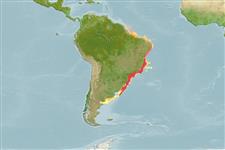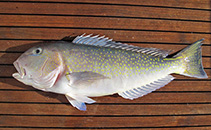Lopholatilus villarii Miranda Ribeiro, 1915
Tile fish
Waarneming toevoegen in Fish Watcher
| Native range | All suitable habitat | Point map | Year 2050 |

|
| This map was computer-generated and has not yet been reviewed. |
| Lopholatilus villarii AquaMaps Data sources: GBIF OBIS |
Uploaden van uw Foto's en video's
Pictures | Google afbeeldingLopholatilus villarii
Picture by de Almeida, F.M.
Pictures | Google afbeeldingLopholatilus villarii
Picture by de Almeida, F.M.
Classificatie / Names Lokale namen | Synoniemen | Catalog of Fishes(Genus, Soort(en)) | ITIS | CoL | WoRMS | Cloffa
> Eupercaria/misc (Various families in series Eupercaria) > Latilidae (Deepwater tilefishes)
Etymology: Lopholatilus: Greek, lophos = crest + Latin, latus = wide (Ref. 45335).
Eponymy: Frederico Otávio de Lemos Villar (1875–1964) was a Brazilian naval officer involved in scientific studies on the Brazilian coast, especially in relation to fisheries. (Ref. 128868), visit book page.
Etymology: Lopholatilus: Greek, lophos = crest + Latin, latus = wide (Ref. 45335).
Eponymy: Frederico Otávio de Lemos Villar (1875–1964) was a Brazilian naval officer involved in scientific studies on the Brazilian coast, especially in relation to fisheries. (Ref. 128868), visit book page.
Environment: milieu / climate zone / depth range / distribution range Ecologie
marien demersaal. Subtropical; 21°S - 40°S, 62°W - 40°W
Verspreiding Landen | FAO regio's | Ecosystemen | Voorkomen | Point map | Introducties | Faunafri
Southwest Atlantic: Brazil, Uruguay, Argentina.
Lengte bij maturiteit / Grootte / Gewicht / Leeftijd
Collected from a depth of 142 m (Ref. 9924).
Levenscyclus en paargedrag Maturiteit | Voortplanting | Paaien | Eieren | Fecunditeit | Larven
Hoofdreferentie
Upload your references | Referenties | Coördinator | Medewerkers
Miranda-Ribeiro, A., 1915. Fauna Brasiliense. Pièxes Arg. Mus. Nat. Rio de J. 17, var. pag. (Ref. 9924)
CITES
Not Evaluated
Gevaar voor de mens
Harmless
Gebruik door de mens
Sportvis: ja
FAO - Publication: search | FishSource |
Meer informatie
Trophic ecology
Voedselitems
Dieetsamenstelling
Voedselconsumptie
Food rations
Predatoren
Voedselitems
Dieetsamenstelling
Voedselconsumptie
Food rations
Predatoren
Ecology
Ecologie
Ecologie
Population dynamics
Groeiparameters
Max. ages / sizes
Length-weight rel.
Length-length rel.
Lengtefrequenties
Massaconversie
Rekrutering
Abundantie
Groeiparameters
Max. ages / sizes
Length-weight rel.
Length-length rel.
Lengtefrequenties
Massaconversie
Rekrutering
Abundantie
Life cycle
Voortplanting
Maturiteit
Maturity/Gills rel.
Fecunditeit
Paaien
Spawning aggregations
Eieren
Ontwikkeling van de eieren
Larven
Larvale populatiedynamiek
Voortplanting
Maturiteit
Maturity/Gills rel.
Fecunditeit
Paaien
Spawning aggregations
Eieren
Ontwikkeling van de eieren
Larven
Larvale populatiedynamiek
Anatomy
Kieuwoppervlak
Brain
Otolith
Kieuwoppervlak
Brain
Otolith
Physiology
Body composition
Nutrients
Zuurstofverbruik
Zwemtype
Zwemsnelheid
Visual pigments
Fish sound
Diseases & Parasites
Toxicity (LC50s)
Body composition
Nutrients
Zuurstofverbruik
Zwemtype
Zwemsnelheid
Visual pigments
Fish sound
Diseases & Parasites
Toxicity (LC50s)
Genetics
Genetica
Heterozygosity
Erfelijkheid
Genetica
Heterozygosity
Erfelijkheid
Human related
Aquaculture systems
Aquacultuurprofielen
Kweeklijnen
Ciguatera cases
Stamps, coins, misc.
Aquaculture systems
Aquacultuurprofielen
Kweeklijnen
Ciguatera cases
Stamps, coins, misc.
Tools
E-boek | Veldgids | Lengtefrequentie Tool | Levenscyclus tool | Verspreidingskaart | Classification Tree
| Catch-MSY |
Speciale rapporten
Bekijk gegevens voor het houden in een aquarium | Bekijk Fact Sheets voor de soort | Bekijk Aquacultuur Fact Sheets
Download XML
Internetbronnen
AFORO (otoliths) | Aquatic Commons | BHL | Cloffa | BOLDSystems | Websites from users | Bekijk FishWatcher | CISTI | Catalog of Fishes: Genus, Soort(en) | DiscoverLife | ECOTOX | FAO - Publication: search | Faunafri | Fishipedia | Fishtrace | GenBank: genoom, nucleotide | GloBI | Google Books | Google Scholar | Google | IGFA World Record | MitoFish | Nationale databanken | Otolith Atlas of Taiwan Fishes | PubMed | Reef Life Survey | Socotra Atlas | Tree of Life | Wikipedia: ga naar, zoek | World Records Freshwater Fishing | Zoobank | Zoological Record
Estimates based on models
Preferred temperature (Ref. 123201): 7.9 - 23.4, mean 14.7 °C (based on 94 cells).
Fylogenetische diversiteitsindex (Ref. 82804): PD50 = 0.7500 [Uniqueness, from 0.5 = low to 2.0 = high].
Bayesian length-weight: a=0.00708 (0.00573 - 0.00875), b=3.14 (3.08 - 3.20), in cm total length, based on LWR estimates for this species (Ref. 93245).
Trofisch niveau (Ref. 69278): 3.8 ±0.2 se; based on size and trophs of closest relatives
Weerstandsvermogen (Ref. 120179): laag, minimale populatieverdubbelingstijd 4,5-14 jaar (tm=5-8).
Fishing Vulnerability (Ref. 59153): High to very high vulnerability (67 of 100).




